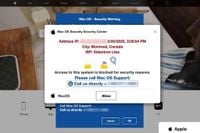Beware, Mac users! A new wave of phishing attacks specifically targeting Apple device owners has emerged. Reported on March 21, 2025, these sophisticated scams have shifted focus from Windows users to Mac users in recent weeks due to enhanced security measures implemented by Microsoft in its browsers.
Cybercriminals are meticulously exploiting compromised domain names that closely resemble well-known brands. For instance, they create deceptive websites with addresses like aplee[.]com, intending to misdirect users to anxiety-inducing web pages. Researchers at LayerX uncovered how these threats imitate the design of legitimate brand sites, including those of Microsoft, and feature urgent prompts for victims to contact technical support.
What’s particularly unsettling is the behavior of these phishing pages. They spontaneously engage web capabilities to create an illusion of a compromised Mac. Users are often met with a full-screen takeover and audio alerts claiming that their device has been blocked because of unauthorized use of its IP address. This tactic, known as “scareware,” is specifically designed to intimidate unsuspecting users into divulging their credentials. As such, it leaves many feeling vulnerable and confused.
This is not the first time that Mac users have been targeted by phishing campaigns, but this particular attack showcases a level of sophistication and adaptability that heightens the risk. LayerX noted that after Microsoft introduced new security features earlier in 2025 that successfully blocked such scams on Windows, phishing attacks targeting that platform decreased by a staggering 90%. As a result, attackers turned their sights on what they perceived as a new and vulnerable audience: Mac users.
According to LayerX’s research, the sound technical security tools implemented in Edge, Chrome, and Firefox browsers have made the execution of phishing attacks on Windows considerably more challenging. This drove cybercriminals to capitalize on what they see as a less secure environment: macOS.
In a related warning, security researchers pointed out the importance ofユーザ—proactive measures for Mac users. They advised individuals to be cautious of any unexpected security alerts and never to enter login credentials on unsecured web pages. Instead, users should ideally maintain up-to-date systems and applications and validate any alarming messages directly through official channels before taking any action.
The scammers have ingeniously found ways to host their phishing pages on legitimate platforms, which considerably increases their credibility. For instance, victims are often led to malware sites that appear as legitimate Windows.net pages, complicating detection efforts.
Researchers believe this meticulous approach could fool even tech-savvy individuals, but they emphasize that everyone, regardless of their technical proficiency, should remain vigilant against such scams. With the rapid evolution of phishing tactics, users are urged to stay informed and cautious.
LayerX highlighted the dangers posed by pop-up windows mimicking Apple’s security alerts. These windows often freeze the user’s web page and can create panic. Without knowledge of potential phishing schemes, many may assume their Mac is genuinely malfunctioning, leading them to take impulsive actions that compromise their data security.
The researchers emphasized the need for heightened awareness, as some users may not recognize these sophisticated phishing attempts as threats. “Even though well-informed users are less likely to fall victim, the frozen web page makes this trick particularly convincing for those less familiar with such scams.”
Experts recommend that in the event of any doubt about legitimate alerts, users should reach out directly to Apple through their official communication channels. They stressed the importance of never conceding personal information or passwords in response to pop-up prompts or unsolicited messages.
Ultimately, users should remain vigilant and take charge of their online safety. With scams rapidly evolving and adapting to circumvent security measures, the responsibility lies with users to keep themselves informed and always verify the legitimacy of online messages.
The current situation underscores the growing threat of phishing for all digital device users. It emphasizes the necessity of continuous education regarding online security and proactive measures that can be crucial in safeguarding personal information.
As the dynamics of cyber threats continue to shift, awareness remains the best defense against falling prey to these malicious schemes. Mac users must remember that they are now in the crosshairs of savvy criminals employing sophisticated tactics designed to deceive.


